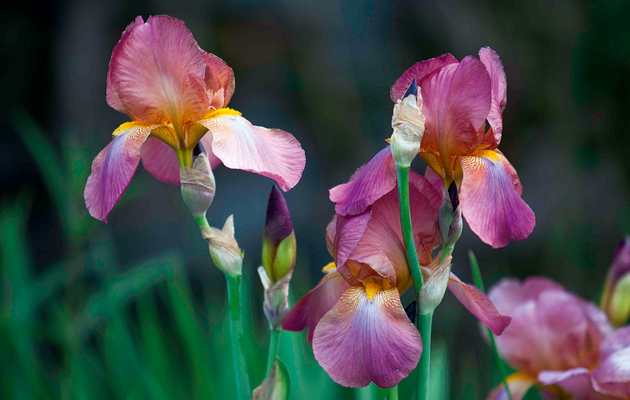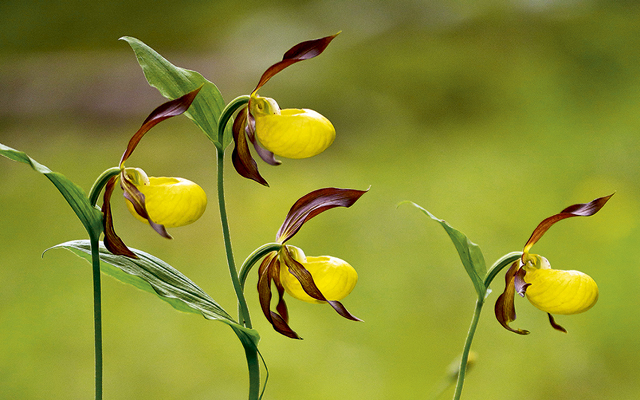How to grow bearded irises
These bearded beauties are worth the effort.


Sissinghurst is well known for its use of colour, its collection of old roses and for the planting combinations, but did you know that Vita and Harold also loved irises? They planted them in all their forms throughout Sissinghurst, collecting many beautiful cultivars. In 1949, Vita wrote: ‘Not everyone, I think, has yet realized the extreme beauty of the Irises... Their beauty is beyond dispute. No velvet can rival the richness of their falls; or, let us say, it is to velvet only that we may compare them. That is surely enough to claim for any flower?’
We continue the tradition of growing irises, from the early-flowering Algerian, Iris unguicularis, whose delicate appearance belies its tough character, to the high-summer-flowering, exotic-looking Iris ensata.
However, it is the wonderfully sculptural, May-flowering bearded irises that delight the most, with their iridescent subtleties of colour in the delicate petals—made up of three upright standards and three downward pointing falls. Each flower has three hairy tongues or beards that protrude seductively and extend down the falls. These are pencilled with faint veins that entice pollinating insects to visit.
The familiar, tall Iris germanica from which the bearded hybrids derive (and which we still grow in the herb garden) is a stately plant, with fragrant blooms of lavender-purple. In the early 20th century, hybridists produced hundreds of new varieties with flowers ranging from clear single tones to subtle blends or contrasts. But these new cultivars had one drawback: often, the stems were too tall and the flowers too large, which meant that they required support. It was the hybridising of these taller kinds with Iris chamaeiris (syn, I. lutescens) that resulted in the development of cultivars of usefully short and intermediate height.
Owing to their vertical, sword- like leaves, irises create an agreeable contrast with old roses and Vita planted many such pairings in the Rose Garden. Old photographs show the irises flowing in rivers beside the paths and spilling into pools under the roses’ skirts and, among the old varieties still in the gardens, are Pink Clover (1953), with rosy standards and pale mauve-washed falls; mutable deep-rose and bronze Three Oaks (1943); and stormy-grey-blue Beotie, bred by Cayeux in 1932.
When planting bearded irises, remember their rhizomes need a thorough summer baking and resent being covered by foliage. We plant bulbs of Allium cristophii into the gaps between the rhizomes, as their leaves are unobtrusive and the globular flower shape delivers a great dialogue with the irises. Elsewhere, the irises soar above a sea of love-in-a-mist, Nigella damascena, the latter’s light and airy foliage disguising the fading leaves of the iris while still allowing the rhizomes to bake.
After about three years, depending on the heaviness of your soil, flowering of the irises will become shy, signalling a need to lift, divide and replant. Irises make their major root growth between July and September and so the best time to lift is after flowering.
Exquisite houses, the beauty of Nature, and how to get the most from your life, straight to your inbox.
Once all the old rhizomes are lifted, break away and discard all but the fattest and strongest pieces. Those remaining can be reduced in length to some 3in–4in and the foliage cut back to a low fan; they should then be replanted in prepared soil at about 12in spacings. If possible, plant all the rhizomes to point the same way, ideally south, to catch the sunshine.
Irises like alkaline soils, so an annual dressing of garden lime— or, preferably, dolomite lime— should be applied to the soil after flowering. Although slow to break down, bone meal is also worthwhile.
During flowering, deadheading spent blooms improves the overall appearance, but, once the entire stem has finished flowering, don’t cut it back. Instead, apply pressure and push the stalk in the same direction as the rhizome, snapping it off at the base.
How to grow fritillaries
Botanical artist and Fritillaria specialist Laurence Hill reveals his top tips.

How to grow lady slipper orchids
Mark Griffiths charts the lasting allure of the lady's slipper.
Country Life is unlike any other magazine: the only glossy weekly on the newsstand and the only magazine that has been guest-edited by His Majesty The King not once, but twice. It is a celebration of modern rural life and all its diverse joys and pleasures — that was first published in Queen Victoria's Diamond Jubilee year. Our eclectic mixture of witty and informative content — from the most up-to-date property news and commentary and a coveted glimpse inside some of the UK's best houses and gardens, to gardening, the arts and interior design, written by experts in their field — still cannot be found in print or online, anywhere else.
